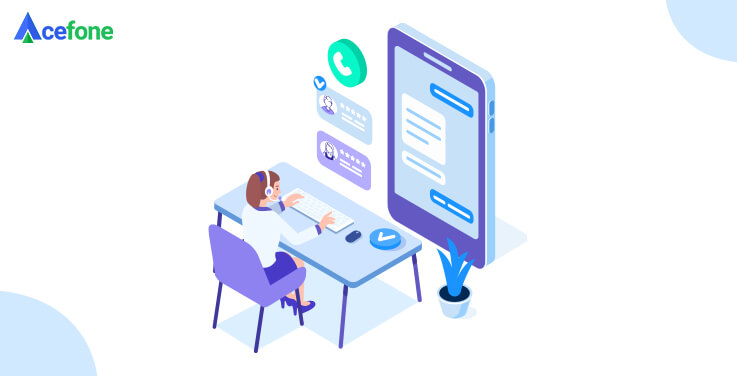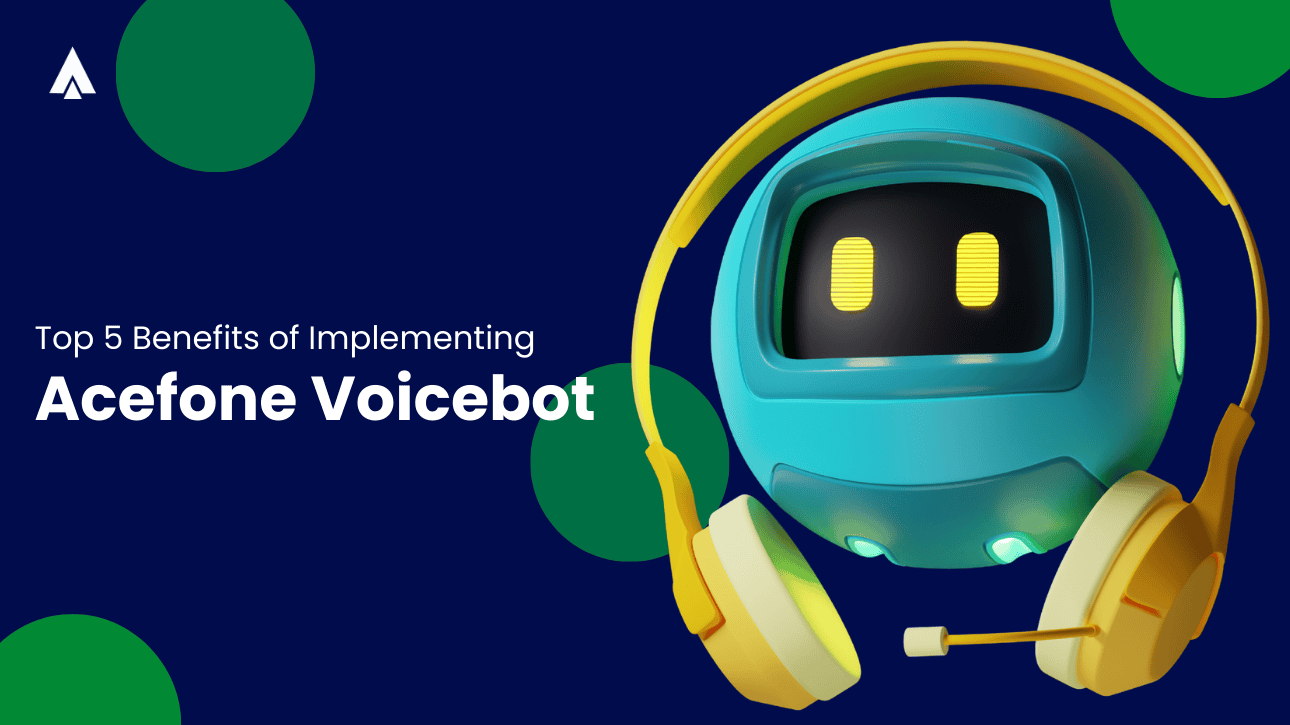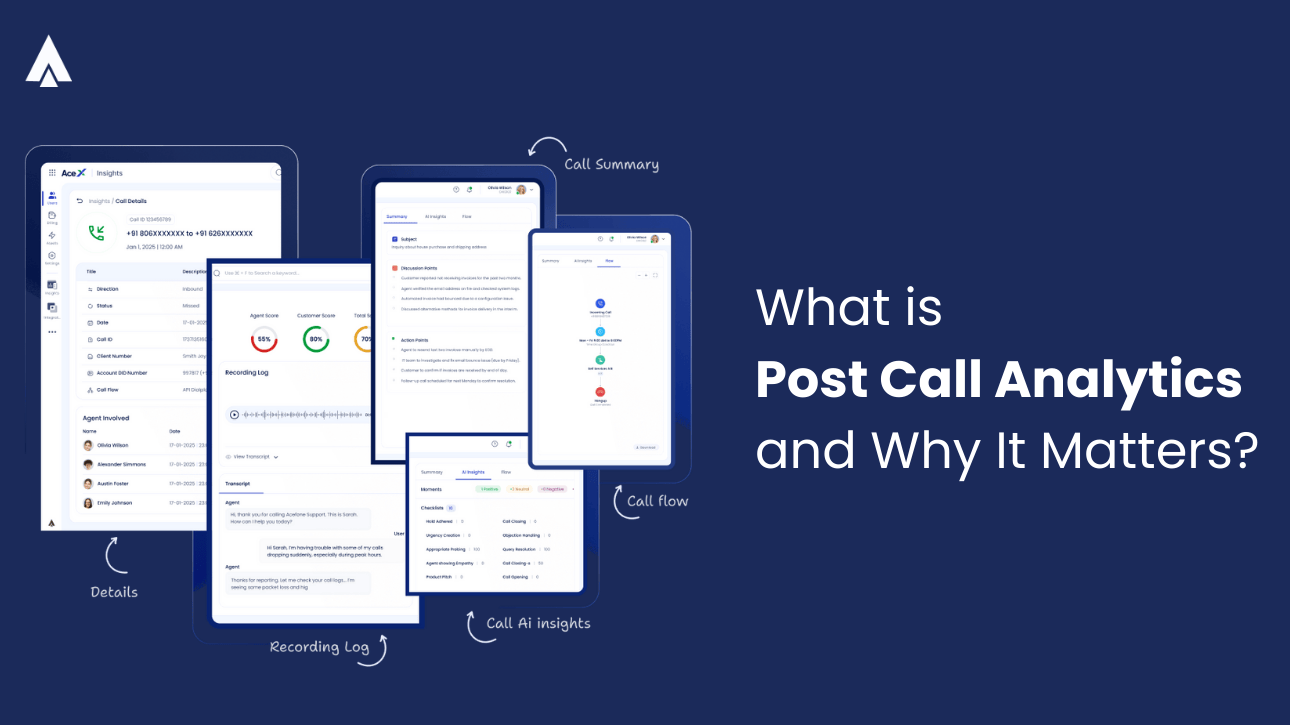Call centers have emerged as a key touchpoint for modern businesses. They enable establishing contact with customers, understanding their demands, and offer quick and efficient solutions.
Though a typical contact center setup reminds us of long call queues and frustrated customers, the modern-day industry has become increasingly streamlined. Backed by cloud-based call center systems, businesses can now offer contextual customer experiences in an organized manner. The global contact center market is expected to grow at a CAGR of 24% by 2030, reaching up to $148 Billion.
Why this rapid growth?
The modern systems come with a variety of cardinal call center features, helping businesses of all sizes communicate efficiently. Considering the rapid digitization of business communication services in recent times, companies are switching to call centers faster than ever.
13 Essential Call Center Features for 2025

1. Interactive Voice Response (IVR)
Interactive Voice Response (IVR) is one of the most foundational call center phone systems features. It helps customers navigate to the concerned customer service agent. The IVR system presents a set of options to the customer in the form of an in-call menu. The customer chooses the concerned department by hitting the corresponding button from the IVR in-call menu.
You can create an IVR flow that allows customers to:
- Press 1 to get the latest product information
- Press 2 to connect with the billing department
- Press 3 to talk to a support agent
Acefone offers you a Multi-level IVR that presents a series of branched questions to understand the root of your concern before connecting you to an agent. Those questions help the IVR systems determine whether the pre-defined answers will suffice, or the customer should be connected to an agent.
2. Automatic Call Distribution (ACD)
Auto Call Distribution is one of the most significant features in hosted contact center software. It helps in routing incoming calls to the appropriate destination in call centers. This system intelligently routes calls based on set criteria such as caller ID, working hours, support level, and IVR selection
The ACD systems acts as an equalizer for businesses aiming to balance the workload among their agents. By implementing the ACD feature into your call center system, you prevent agents from performance burnout and maintain their productivity.
3. Call Monitoring
Call monitoring is crucial part of a call center systems. It allows managers and supervisors to observe conversations in real time, utilizing them as reference material to train recruits. It also allows stakeholders to monitor the department’s overall progress, track KPIs, and device strategies to improve customer experience.
Call monitoring in a vital call center features that involves call whispering and call barging. These two functionalities allow supervisors to jump on live calls and assist in query resolution.
Call whispering allows supervisors to join and assist agents in providing a relevant solution without letting the customer know. On the contrary, call barging enables supervisors to take over the call and deliver a solution themselves.
Recommended Read: Call Center Software Costs
4. Skill-based Routing
Customer service agents work based on their expertise. They are categorized depending on their experience, languages known, and skillset. In an omnichannel contact center solution, skill-based routing is a key feature that enables directing customers to the most appropriate customer service agent for specific instances.
Consider an example of a French-speaking customer who has contacted the call center for assistance about network issues. Connecting him with a non-technical Chinese speaking agent will result in poor customer experience. Skill-based routing eliminates such a scenario and empowers seamless routing.
5. Multiple Dialing Methods
You’ll be surprised to know that sales agents spend almost 65% of their time on administrative work, sidelining their priority tasks. This is why they need a solution that can handle routine tasks like dialing and data management so that they can focus on having quality conversations.
Modern call center software offers various dialing methods to match different campaign goals and lead types. One such method is the preview dialing, which lets agents see customer details before making a call. This helps them prepare better and tailor conversations for each lead.
Preview dialers are ideal for high-value or complex leads that need a more personalized approach. They also reduce time spent on manual admin tasks, helping agents focus on revenue-generating activities.
Other dialing options include progressive dialers (which auto-dial numbers one by one as agents become available) and predictive dialers (which use algorithms to dial multiple numbers and connect answered calls to free agents).
By offering multiple dialing methods, call centers can boost productivity, improve lead engagement, and run smarter, more targeted campaigns.

6. Call Transfer
The live call transfer feature is another handy call center software features, enabling agents to transfer calls to other agents, supervisors, or an IVR without disconnecting.
To successfully transfer an ongoing call, the current agent takes the customer’s consent and initiates a call transfer request through the portal. The corresponding agent/ supervisor receives the request, given they are available. The current agent then briefs them about the case, while the customers wait on hold.
Post briefing the customer is then connected to the new agent/supervisor and the call continues from there. The live transfer saves both parties abundant time as the customer needn’t connect over a new call to discuss their issues. It acts as a bridging tool in a call center system ensuring agents can provide the most relevant solution to customers.
Read this blog : Hosted Contact Center Software
7. Voicemail Transcription
Voicemail-to-email is one of the most important call center software features. It offers significant advantages for agents and contributes to departmental progress. Call center agents can receive voicemails directly in their email inbox, ensuring prompt responses to customer inquiries.
It comes handy when agents miss the customer’s initial call. This convenience and flexibility empower agents to stay connected and address customer needs from any location.
Acefone’s Voicemail-to-email feature facilitates efficient documentation and follow-up on customer cases. Agents can easily archive and review voicemail recordings for accurate tracking and query resolution.
Additionally, call center systems can leverage voicemail data for performance monitoring and analysis, driving consistent improvement in agent performance and overall departmental processes.
8. CRM Integrations
Almost every call center system involves a CRM integration in place to help agents deliver personalized experiences. The technology provides agents with information like customer names, ticket types, chat transcripts, etc.
Such vital information helps agents work in an efficient and organized manner and provide relevant solutions to customers, ensuring higher CSAT levels. Acefone offers CRM integration with a pool of industry leading platforms. Some of the call center system’s integrations include Microsoft Teams, Pipedrive, Zoho, Salesforce, and HubSpot.
Users can add any of the available integrations at Acefone with a simple toggle provided on the call center system’s portal. Once turned on, the integration becomes active and is ready for use across any of the user’s registered devices.
Learn what is outbound call center and how CRM integrations can streamline your customer interactions with Acefone.
9. Real-Time Call Reporting
Real-time monitoring provides detailed insights into agent-customer interactions and several service level metrics. Some of these metrics include average call waiting time, maximum waiting time, average handling time, and the average number of agents available.
Real-time call monitoring helps stakeholders make informed decisions on par with the organization’s objectives. The information can also be used to make strategic decisions, boost call center system efficiency, and customer experiences.
Read our blog: Contact center vs Call center
10. Reporting and Analytics
Call reporting capabilities help call center systems make data-driven decisions. It has a significant impact on the organization as it enables supervisors to view performance levels on an intrinsic as well as overall depth. Managers and stakeholders can monitor agent performances, evaluate call quality, identify potential bottlenecks, and contribute towards the overall process improvement.
Acefone’s analytical data provides its users with a closer look at their team’s workload and helps them identify deviations simultaneously. This call center system feature helps them make effective staffing decisions in the long run.
Learn more about the difference between inbound and outbound call center operations to refine your customer service strategy.
11. Post-Conversation Analytics
Customer conversations hold a treasure trove of insights, but only if you know where to look. AI-powered call center features like post-call analytics offer deep insights into sentiment, agent performance, and compliance issues. It helps identify customer sentiment, compliance issues, and agent performance gaps.
Acefone’s post-call analytics empowers businesses to track churn signals, monitor service quality, and drive training improvements. Industries like BFSI, healthcare, and telecom use it to ensure compliance and proactively retain customers, leading to up to 15% better retention and 20% less churn.
Read our blog: What is Click to Call?
12. Pre-Call Agent Assist
Agents often struggle with information overload or a lack of context during live interactions. Pre-Call Agent Assist is a contact center features that solves this problem. It offers real-time recommendations, contextual data, and next-best actions drawn from CRM systems and past interactions.
This helps reduce average handling time and improves first-call resolution. More importantly, it personalizes conversations, making customers feel understood and valued. It’s especially useful in industries where speed and accuracy are critical, like telecom, banking, and healthcare.
Recommended Read- What is a Call Center?
13. Voice Bots
Voice bots are transforming the way businesses handle high volumes of customer queries. These AI-driven tools can answer FAQs, schedule appointments, process orders, and provide account information—all in natural, conversational language.
They operate 24/7, offering immediate support and reducing the load on human agents. Voice bots are scalable, cost-efficient, and increasingly essential in sectors like retail, BFSI, and telecom, where customer expectations are high, and resources are often stretched.
In a Nutshell
Call center systems are not restricted to features like call forwarding and recording. They have grown enormously by adopting state-of-the-art capabilities like AI, real time analytics, auto dialers, IVR, live chat, and CRM integration.
These technological advancements have contributed immensely to the smooth functioning of call center systems. We hope the above-mentioned points provide a detailed view of a call center’s capabilities and how they help in improving business efficiency.
If you find these contact center features helpful and think that they might help you streamline your business communications, feel free to get in touch with our experts for a free trial.
FAQs:
Modern call center features include AI support, CRM integrations, real-time analytics, and omnichannel communication. Unlike traditional setups, they are cloud-based, scalable, and enable remote operations, making them more cost-effective and flexible for growing businesses.
Call center software features improve support by enabling faster response times, personalized interactions, and better resource allocation. Tools like skill-based routing, live call monitoring, and automated dialing help deliver seamless customer service experiences across industries.
You can benefit from call center features like AI, IVR, ACD, CRM integration, voicemail-to-email, and real-time reporting. These features improve service quality, reduce agent workload, and provide insights that help in scaling operations efficiently.
CRM integration connects customer data to the calling This enables agents to access history, preferences, and open tickets during calls. It’s one of the top contact center features that boosts personalization and shortens resolution times.
Skill-based routing connects customers to the most qualified agents based on language, expertise, or issue type. It’s a crucial contact center features that improves first-call resolution, enhances customer satisfaction, and optimizes agent efficiency.
Acefone offers AI-powered call reporting with metrics like wait time, agent availability, and handling time. These features help managers make informed decisions, optimize staffing, and boost performance through actionable insights.
Yes. Auto dialers, IVR, call transfer, and voicemail-to-email, are some of Acefone’s call center features automate repetitive tasks. This allows agents to focus on meaningful conversations, increasing productivity, and reducing burnout.
Acefone uses AI and NLP to analyze recorded conversations. They identify customer sentiment, monitor compliance, and highlight coaching opportunities, helping teams reduce churn and improve service quality.














